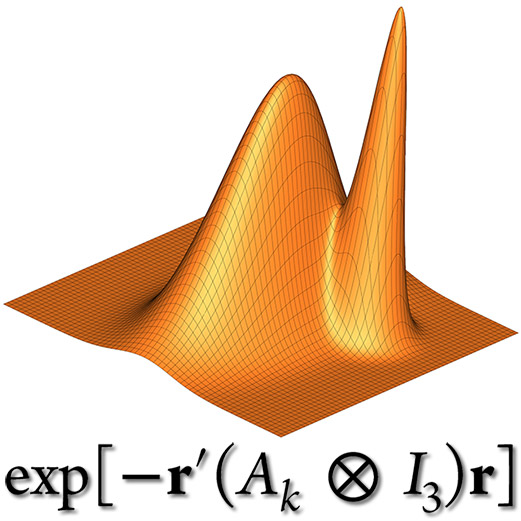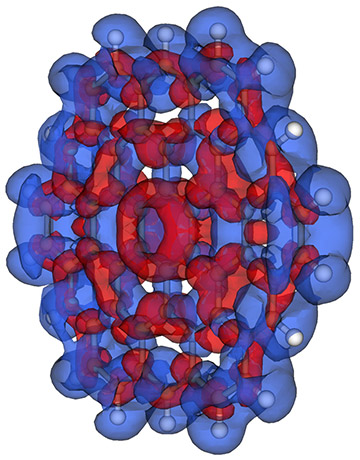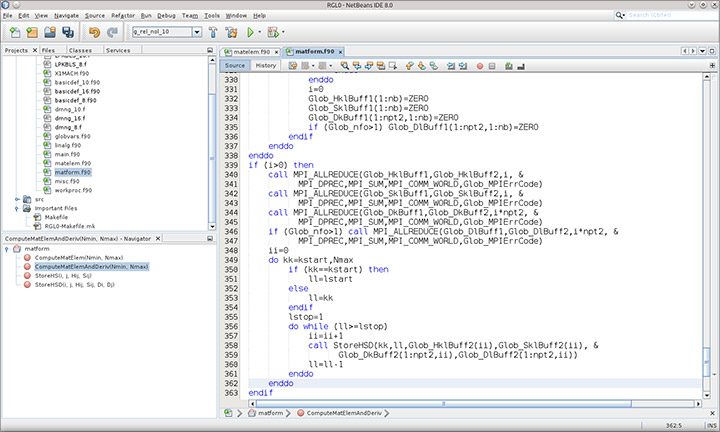|
We welcome motivated students who would like to do research in computational physics.
Interested students are encouraged to send inquiries via email or simply drop by the
office and chat (see the Contact tab).
Our research interests are concentrated in the field computational quantum mechanics, which spans
quantum chemistry, electronic structure, few-body physics, atomic and molecular physics,
quantum dynamics, nanoscience, and solid state physics.
-
One of our main and continuously sustained activity
has been the development and applications of methods that utilize
all-particle explicitly correlated Guassians
in quantum mechanical calculations of various quantum systems.
Explicitly correlated Gaussian (ECG) basis sets have a wide range of applications
in chemistry and physics and provide a very powerful tool to solve
quantum few-body problem with all kinds of interparticle interaction.
 In particular, we are interested in theoretical spectroscopy of few-electron
atoms and molecules with and without assuming the Born-Oppenheimer approximation.
High precision calculations on such systems require the use of state-of-the-art
computational approaches. Treatment of relativistic corrections is also often necessary
for comparison with highly accurate experimental data.
In particular, we are interested in theoretical spectroscopy of few-electron
atoms and molecules with and without assuming the Born-Oppenheimer approximation.
High precision calculations on such systems require the use of state-of-the-art
computational approaches. Treatment of relativistic corrections is also often necessary
for comparison with highly accurate experimental data.
Small systems containing positrons and other exotic particles are another class
of quantum systems we have been investigating. Over the last decades there has been a
lot of speculation about whether positrons could bind to atoms and if so what is
the mechanism of this binding. The question of dynamical stability of positronic systems
is non-trivial as positron binding is usually quite weak. Reliable calculations help
to answer that question and provide accurate estimates of the average lifetimes and
other properties.
Recently, we also became interested
in studying the properties of confined systems of electrons and holes in semiconductors.
Within the effective mass approximation, ECG basis sets
allow accurate determination of the binding energies and electron-hole recombination
probabilities in quantum dots with multiple excitons and study the effect
of the dot size and geometry.
The scope of possible applications of ECGs is still not fully explored.
Quantum few-body problem is of frequent occurence
in many areas of physics. Thus, the ability to solve it accurately
is of great importance. The ultimate goal of our effort is to develop a
general, efficient, and predictive framework that can be succesfully used in various
applications ranging from atomic systems to quarks.
-
Light-matter interaction is at the heart of many conceptual,
foundational and applicational endeavours in physics. With the emergence
and ever increasing use of high power coherent light sources
new prospects open up
to steer and control the motion of electrons and nuclei in atoms, molecules,
and condensed matter systems. However, it requires a good undestanding
of the underlying quantum dynamics.
 This is why computer simulations of strong field phenomena
have been playing an important role in femto- and atto-second science.
In our work we pursue the theoretical and computational studies of
various laser-induced phenomena in time domain.
In particular, our work is centered around the applications of time-dependent
density functional theory (TDDFT) to study the processes of excitation,
ionization, fragmentation, and bond scission in molecules and nanosystems. Our
simulations also deal with the modeling of Coulomb explosion in small molecules
and other strong field processes.
All of the above processes become significant at the laser field intensities
comparable by order of magnitude to the field that binds electrons
in atoms in molecules (around 1014-1016 W/cm2).
Selective manipulation of chemical bonds can enable novel synthesis
of molecular species and materials with new functionalities. At the same time,
ultrashort (just a few femtoseconds) probes allow resolving the evolution
of nuclear and electronic subsystems and provides an insight into
the nature of light-matter interaction at the atomic scale.
This is why computer simulations of strong field phenomena
have been playing an important role in femto- and atto-second science.
In our work we pursue the theoretical and computational studies of
various laser-induced phenomena in time domain.
In particular, our work is centered around the applications of time-dependent
density functional theory (TDDFT) to study the processes of excitation,
ionization, fragmentation, and bond scission in molecules and nanosystems. Our
simulations also deal with the modeling of Coulomb explosion in small molecules
and other strong field processes.
All of the above processes become significant at the laser field intensities
comparable by order of magnitude to the field that binds electrons
in atoms in molecules (around 1014-1016 W/cm2).
Selective manipulation of chemical bonds can enable novel synthesis
of molecular species and materials with new functionalities. At the same time,
ultrashort (just a few femtoseconds) probes allow resolving the evolution
of nuclear and electronic subsystems and provides an insight into
the nature of light-matter interaction at the atomic scale.
-
Nanoscience and nanotechnology, which aim to manipulate matter at the atomic scale, are
revolutionizing science and industry.
 Through the development of new devices used in
everyday life these fields will have a huge societal impact in the near future.
Currently, the majority of computational studies in nanoscience focus on the static behavior
of materials. Such studies provide useful information about the structure and various properties.
However, understanding of many phenomena in physics, chemistry, materials science,
and energy-related fields often requires knowledge of the electron and ion dynamics.
Part of our research effort is focused on applications and computer simulations of
quantum dynamics in nanostructures. Thus research has included the modeling of field
emission in carbon nanotubes, laser-assisted desorption of atoms from surfaces,
simulating the interaction of energetic ions with materials (energy transfer, possibility
of defect creation in 2D structures), and other applications.
The main goal of this effort is to provide quantitative understanding and enhance our
knowledge about the electron dynamics at the nanoscale
Through the development of new devices used in
everyday life these fields will have a huge societal impact in the near future.
Currently, the majority of computational studies in nanoscience focus on the static behavior
of materials. Such studies provide useful information about the structure and various properties.
However, understanding of many phenomena in physics, chemistry, materials science,
and energy-related fields often requires knowledge of the electron and ion dynamics.
Part of our research effort is focused on applications and computer simulations of
quantum dynamics in nanostructures. Thus research has included the modeling of field
emission in carbon nanotubes, laser-assisted desorption of atoms from surfaces,
simulating the interaction of energetic ions with materials (energy transfer, possibility
of defect creation in 2D structures), and other applications.
The main goal of this effort is to provide quantitative understanding and enhance our
knowledge about the electron dynamics at the nanoscale
-
Developing parallel computer codes for large scale scientific computations
has been an integral part of our research.
 Computer modeling of complex systems
not only requires the use of powerful computational resources but also sophisticated
and highly efficient computational approaches.
Adaptation of numerical algorithms and achieving adequate scalability for parallel
execution in shared and distributed memory environment is a key
ingredient (in fact, a necessity) that allows to perform simulations
with permanently increasing system size and accuracy requirements.
Computer modeling of complex systems
not only requires the use of powerful computational resources but also sophisticated
and highly efficient computational approaches.
Adaptation of numerical algorithms and achieving adequate scalability for parallel
execution in shared and distributed memory environment is a key
ingredient (in fact, a necessity) that allows to perform simulations
with permanently increasing system size and accuracy requirements.
We maintain some (practical) interest in numerical linear algebra and optimization, as well
as in many other areas related to scientific computing.
Most of the simulations we perform make use of our in-house computer codes. We have
developed and maintained
the codes for few-body quantum-mechanical simulations with various forms of explicitly correlated
Gaussians. We have also participated in the development of of the code for
computer simulations in the framework of real-space real-time time-dependent density
functional theory.
|

 In particular, we are interested in theoretical spectroscopy of few-electron
atoms and molecules with and without assuming the Born-Oppenheimer approximation.
High precision calculations on such systems require the use of state-of-the-art
computational approaches. Treatment of relativistic corrections is also often necessary
for comparison with highly accurate experimental data.
In particular, we are interested in theoretical spectroscopy of few-electron
atoms and molecules with and without assuming the Born-Oppenheimer approximation.
High precision calculations on such systems require the use of state-of-the-art
computational approaches. Treatment of relativistic corrections is also often necessary
for comparison with highly accurate experimental data.
 This is why computer simulations of strong field phenomena
have been playing an important role in femto- and atto-second science.
In our work we pursue the theoretical and computational studies of
various laser-induced phenomena in time domain.
In particular, our work is centered around the applications of time-dependent
density functional theory (TDDFT) to study the processes of excitation,
ionization, fragmentation, and bond scission in molecules and nanosystems. Our
simulations also deal with the modeling of Coulomb explosion in small molecules
and other strong field processes.
All of the above processes become significant at the laser field intensities
comparable by order of magnitude to the field that binds electrons
in atoms in molecules (around 1014-1016 W/cm2).
Selective manipulation of chemical bonds can enable novel synthesis
of molecular species and materials with new functionalities. At the same time,
ultrashort (just a few femtoseconds) probes allow resolving the evolution
of nuclear and electronic subsystems and provides an insight into
the nature of light-matter interaction at the atomic scale.
This is why computer simulations of strong field phenomena
have been playing an important role in femto- and atto-second science.
In our work we pursue the theoretical and computational studies of
various laser-induced phenomena in time domain.
In particular, our work is centered around the applications of time-dependent
density functional theory (TDDFT) to study the processes of excitation,
ionization, fragmentation, and bond scission in molecules and nanosystems. Our
simulations also deal with the modeling of Coulomb explosion in small molecules
and other strong field processes.
All of the above processes become significant at the laser field intensities
comparable by order of magnitude to the field that binds electrons
in atoms in molecules (around 1014-1016 W/cm2).
Selective manipulation of chemical bonds can enable novel synthesis
of molecular species and materials with new functionalities. At the same time,
ultrashort (just a few femtoseconds) probes allow resolving the evolution
of nuclear and electronic subsystems and provides an insight into
the nature of light-matter interaction at the atomic scale.
 Through the development of new devices used in
everyday life these fields will have a huge societal impact in the near future.
Currently, the majority of computational studies in nanoscience focus on the static behavior
of materials. Such studies provide useful information about the structure and various properties.
However, understanding of many phenomena in physics, chemistry, materials science,
and energy-related fields often requires knowledge of the electron and ion dynamics.
Part of our research effort is focused on applications and computer simulations of
quantum dynamics in nanostructures. Thus research has included the modeling of field
emission in carbon nanotubes, laser-assisted desorption of atoms from surfaces,
simulating the interaction of energetic ions with materials (energy transfer, possibility
of defect creation in 2D structures), and other applications.
The main goal of this effort is to provide quantitative understanding and enhance our
knowledge about the electron dynamics at the nanoscale
Through the development of new devices used in
everyday life these fields will have a huge societal impact in the near future.
Currently, the majority of computational studies in nanoscience focus on the static behavior
of materials. Such studies provide useful information about the structure and various properties.
However, understanding of many phenomena in physics, chemistry, materials science,
and energy-related fields often requires knowledge of the electron and ion dynamics.
Part of our research effort is focused on applications and computer simulations of
quantum dynamics in nanostructures. Thus research has included the modeling of field
emission in carbon nanotubes, laser-assisted desorption of atoms from surfaces,
simulating the interaction of energetic ions with materials (energy transfer, possibility
of defect creation in 2D structures), and other applications.
The main goal of this effort is to provide quantitative understanding and enhance our
knowledge about the electron dynamics at the nanoscale
 Computer modeling of complex systems
not only requires the use of powerful computational resources but also sophisticated
and highly efficient computational approaches.
Adaptation of numerical algorithms and achieving adequate scalability for parallel
execution in shared and distributed memory environment is a key
ingredient (in fact, a necessity) that allows to perform simulations
with permanently increasing system size and accuracy requirements.
Computer modeling of complex systems
not only requires the use of powerful computational resources but also sophisticated
and highly efficient computational approaches.
Adaptation of numerical algorithms and achieving adequate scalability for parallel
execution in shared and distributed memory environment is a key
ingredient (in fact, a necessity) that allows to perform simulations
with permanently increasing system size and accuracy requirements.